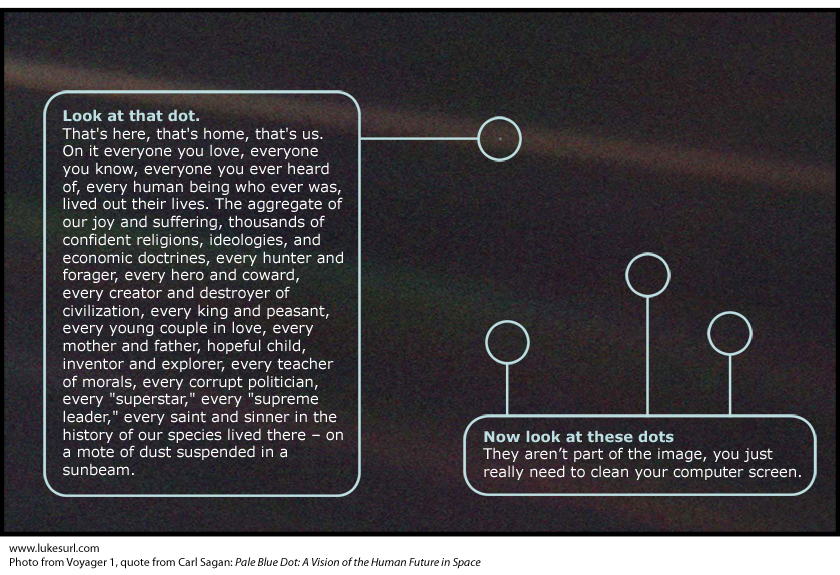 So now we know.
So now we know.
Is This Your Hat?
11 years ago
Miscellaneous thoughts on politics, people, math, science and other cool (if sometimes frustrating) stuff from somewhere near my favorite coffee shop.
 So now we know.
So now we know.
 I've been meaning to mention this for a while, but all sorts of news has been all sorts of crazy for the past week and more. On top of that, Interzone has (finally) switched ISP's, but the wifi is still buggy for long stretches at a time. To describe browsing as glacially slow would malign the celerity of glaciers. But in about two hours, the MESSENGER probe will fire its main engines for 15 minutes, allowing itself to be gravitationally captured, and become the first man-made object to orbit Mercury. The Planetary Society Blog has the time line and web resources (as well as the image above at a larger size) to follow it live, if that's your thing.
I've been meaning to mention this for a while, but all sorts of news has been all sorts of crazy for the past week and more. On top of that, Interzone has (finally) switched ISP's, but the wifi is still buggy for long stretches at a time. To describe browsing as glacially slow would malign the celerity of glaciers. But in about two hours, the MESSENGER probe will fire its main engines for 15 minutes, allowing itself to be gravitationally captured, and become the first man-made object to orbit Mercury. The Planetary Society Blog has the time line and web resources (as well as the image above at a larger size) to follow it live, if that's your thing.At 9:10 p.m. EDT, engineers in the MESSENGER Mission Operations Center at the Johns Hopkins University Applied Physics Laboratory (APL) in Laurel, Md., received the anticipated radiometric signals confirming nominal burn shutdown and successful insertion of the MESSENGER probe into orbit around the planet Mercury.
The spacecraft rotated back to the Earth by 9:45 p.m. EDT, and started transmitting data. Upon review of these data, the engineering and operations teams confirmed that the burn executed nominally with all subsystems reporting a clean burn and no logged errors.
MESSENGER’s main thruster fired for approximately 15 minutes at 8:45 p.m., slowing the spacecraft by 1,929 miles per hour (862 meters per second) and easing it into the planned eccentric orbit about Mercury. The rendezvous took place about 96 million miles (155 million kilometers) from Earth.
“Achieving Mercury orbit was by far the biggest milestone since MESSENGER was launched more than six and a half years ago,” says MESSENGER Project Manager Peter Bedini, of APL. “This accomplishment is the fruit of a tremendous amount of labor on the part of the navigation, guidance-and-control, and mission operations teams, who shepherded the spacecraft through its 4.9-billion-mile [7.9-billion-kilometer] journey.”
For the next several weeks, APL engineers will be focused on ensuring that MESSENGER’s systems are all working well in Mercury’s harsh thermal environment. Starting on March 23, the instruments will be turned on and checked out, and on April 4 the primary science phase of the mission will begin.
“Despite its proximity to Earth, the planet Mercury has for decades been comparatively unexplored,” adds MESSENGER Principal Investigator Sean Solomon, of the Carnegie Institution of Washington. “For the first time in history, a scientific observatory is in orbit about our solar system’s innermost planet. Mercury’s secrets, and the implications they hold for the formation and evolution of Earth-like planets, are about to be revealed.”
 (The Daily What) I had to read this one twice to catch the gag. Once while working in the forest soils lab, I spilled some lab grade (37% -home use formula is 2%) hydrogen peroxide on my wrist- I hadn't properly pulled my glove up. Within seconds, I was rinsing it off, so there was no serious damage, but even those few seconds was enough to bleach my skin utterly white. And there's nothing like having a white blotch an inch or so across on your wrist for a couple of weeks to convince one's self that Caucasian people aren't actually white. Also, to be convinced that if you read or are warned a particular reagent is much more dangerous than you might think, it's a good idea to simply accept it, and not to test the claim empirically.
(The Daily What) I had to read this one twice to catch the gag. Once while working in the forest soils lab, I spilled some lab grade (37% -home use formula is 2%) hydrogen peroxide on my wrist- I hadn't properly pulled my glove up. Within seconds, I was rinsing it off, so there was no serious damage, but even those few seconds was enough to bleach my skin utterly white. And there's nothing like having a white blotch an inch or so across on your wrist for a couple of weeks to convince one's self that Caucasian people aren't actually white. Also, to be convinced that if you read or are warned a particular reagent is much more dangerous than you might think, it's a good idea to simply accept it, and not to test the claim empirically.
A stone mason with a powerful phobia of indoor lighting was accused of misrepresenting the "black granite" he used in a counter top. He was charged with basalt, but when his condition came to light, the charges were dismissed due to lamprophyre.Geologists have a perennial gripe with the phrase "black granite," which is like a furry fish: there ain't no such thing. "Charged with basalt" seems obvious, but I don't think I've ever heard this pun before. And I got a giggle out of "lamprophyre" interpreted as a phobia of indoor lighting. Lamprophyres are weird, obscure rocks that no normal person would ever need to know about, therefore, I'm very fond of them. My favorite was an outcrop near the eastern end of lake Nipissing in Ontario with awesome veins of barite, which has sadly been mostly obliterated by road construction.
 Maneggs
Maneggs Firedoglake
Firedoglake "The Stalker" Bits and Pieces
"The Stalker" Bits and Pieces What Would Jack Do?
What Would Jack Do? Alphaville
Alphaville The High Definite
The High Definite Bad Astronomy
Bad Astronomy Darius Whiteplume's Tumblr
Darius Whiteplume's Tumblr Very Demotivational
Very Demotivational Surviving the World
Surviving the World E.B. Misfit
E.B. Misfit Bits and Pieces
Bits and Pieces Criggo
Criggo The High Definite
The High Definite Blackadder
Blackadder Balloon Juice
Balloon Juice Blackadder
Blackadder Blackadder
Blackadder Alphaville
Alphaville Hipster Hitler
Hipster Hitler Double take, from Sofa Pizza
Double take, from Sofa Pizza Eff yeah: ROCKS! EpicPonyz
Eff yeah: ROCKS! EpicPonyz Luke Surl
Luke Surl
